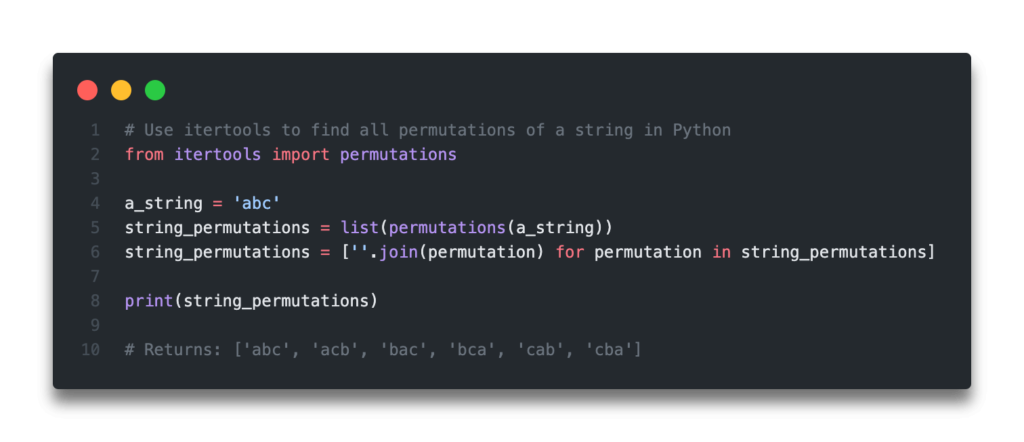

Raise Exception("unsupported type! "+str(img.size())) Raise Exception("unsupported type! " + str(img.size())) To use the permutations () method, we need to import the itertools package.
#Permute python code#
The itertools.permutations () method takes a list, dictionary, tuple, or other iterators as a parameter and returns the permutations of that list. If you look at the code of permute, youll again see the core loop iterating over all our input data: for elem in inputData.

Print('warning: more than 3 channels! only channels 0,1,2 are preserved!')Įlif bz > 1 and c = 1: # multiple grayscale imagesĮlif bz > 1 and c = 3: # multiple RGB imagesĮlif bz > 1 and c > 3: # multiple feature maps To calculate permutations in Python, use the itertools.permutation () method. If bz=1 and c=1: # single grayscale imageĮlif bz=1 and c > 3: # multiple feature maps Show(x,y,z) produces three windows, displaying x, y, z respectively, where x,y,z can be in any form described above. If x is a 2D tensor, it will be shown as grayscale map If x is a 3D tensor, this function shows first 3 channels at most (in RGB format) If x is a 4D tensor (like image batch with the size of b(atch)*c(hannel)*h(eight)*w(eight), this function splits x in batch dimension, showing b subplots in total, where each subplot displays first 3 channels (3*h*w) at most. Show(x) gives the visualization of x, where x should be a torch.Tensor Input imgs can be single or multiple tensor(s), this function uses matplotlib to visualize. I've written a simple function to visualize the pytorch tensor using matplotlib. # If you try to plot image with shape (C, H, W) Tensor_image = tensor_image.view(tensor_image.shape, tensor_image.shape, tensor_image.shape) Print(type(tensor_image), tensor_image.shape) If x is a multi-dimensional array, it is only shuffled along its first index. But PyTorch Tensors ("Image tensors") are channel first, so to use them with matplotlib you need to reshape it: Randomly permute a sequence, or return a permuted range. The permutation is applied as outputDimensionIndex permutationinputDimensionIndex, so to permute from CHW order to HWC order, the required permutation. The permutation feature importance is defined to be the decrease in a model score when a single feature value is. This is especially useful for non-linear or opaque estimators. We benchmarked several other alternatives (see the thread "list conversion question") and this was the fastest and simplest.As you can see matplotlib works fine even without conversion to numpy array. Permutation feature importance is a model inspection technique that can be used for any fitted estimator when the data is tabular. The key insight by Peter Otten is that the list to decorate isn't the input list, it's the indices list, and the input list's _getitem_ can be used to get the key for that index. The 'key' parameter was added to sort in Python 2.4 to make it easier to do DSU. The standard solution for this is the "DSU" (for Decorate-Sort-Undecorate), also called the Schwartzian transform from the Perl community. To list the color values in order you need to find the position of the largest item in the histogram and get the color with the same index, then the second largest, etc.

In the original context on there was a histogram function which returned a list where the length of the list was the number of colors in the color table and the elements the repeat count of the corresponding color. Sometimes you need to know how a list would be sorted but not actually sort it.


 0 kommentar(er)
0 kommentar(er)
